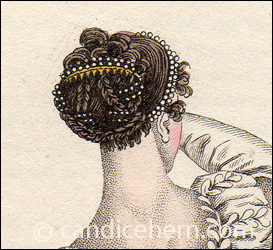
Readers report that one of the many reasons they love to read historical romances is the beautiful clothing and hairstyles characters wear. Even though modern-day readers are usually happy to wear comfy jeans or shorts, a soft t-shirt, and hair in a ponytail, we love wearing vicariously through characters those beautiful silk or muslin gowns and our long, thick hair swept up into an elegant chignon.
At first glance, the Regency Era allows little room for veering off conventional norms for ladies of the upper classes who wanted to be fashionable, or at least, whose mothers wanted them to be fashionable to attract eligible bachelors “in want of a wife,” as Jane Austen put it.
It turns out, despite definite trends in hairstyles, for individual taste created some wiggle-room in styles. As I searched for images, finding daytime hairstyles proved difficult because most daywear fashion prints show head coverings such as mobcaps, bonnets, and hats. Therefore, many of the images here are for evening wear.
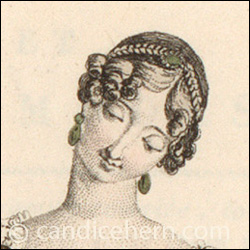
Spanning the Regency Era, 1811 to 1820, are the findings of my research.
Trends
Parting and Forehead Exposure
Throughout the Regency period, there is a consistent trend of parting the hair to display the forehead. For example, many styles describe hair as “divided on the forehead” or “parted on the forehead” or even “so as to display the forehead and eyebrows.”

Curls and Ringlets
Curls and ringlets are prominent features in many of the descriptions. Hairstyles often include “full curls,” “wave curls,” “loose curls,” or “ringlets” on the sides and front of the hair, and “A few ringlets to hang from the crown of the head to the throat but not suffered to fall into the neck.” (Ackermann’s May 1820) and “with round curls on each side of the face and a few long.” (Cunnington)
In 1813 and 1816, appear the wording “a single hanging ringlet hanging down the back” and “For the ball hair is twisted up behind and dressed in full curls in the front with a bandeau.” (Cunnington)
High and Low Hair
The contrast between high and low hairstyles is a recurring theme. High hairstyles, such as those with “a high tuft” or “brought up very high,” contrast with styles where the hair is “dressed very low” or “brought low at the sides.” Today, we use the words bun or chignon for what they called a “tuft.”
Front hair and “hind hair’ appears throughout the descriptions. For example, “The hair, which is much part on the forehead, is dress very little with the sides, and the hind hair brought to a very moderate height. (Ackermann’s Repository, Evening dress February 1817)
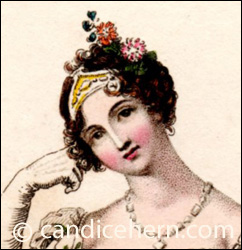
Ornaments and Headpieces
Various accessories such “bandeau,” “barrel comb,” “pearl comb,” “garland of roses,” “aigrette,” “diadem head-dress,” and “wreath” commonly appear. These accessories enhance and embellish hairstyles, especially for evening wear.
Ostrich feathers frequently adorned headpieces for evening wear and especially when appearing at court.
Volume and Fullness
Many hairstyles feature a significant amount of volume, with descriptions including “full curls,” “full ringlets,” and “full bows” at both the front and back of the head. Bows are voluminous curls arranged with pins or accessories to form a bow shape.
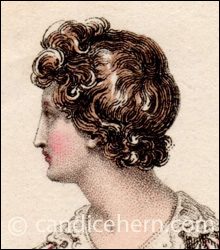
Hair Length
Many styles require long or medium length hair, considering the amount of full curls or ringlets in the descriptions. By 1814, “hair is fast gaining an ascendancy over the short, and is now worn very low in the neck behind.” (Cunnington)
Though popular for a time during the Georgian Era, mention of short hair appears in only one Regency Fashion plate that I found: “hair cropped, and dressed in very full curls in the neck, and very full on the forehead.” (Ackermann’s September 1816).
Inspired by other Countries
Late Georgian and early Regency hairstyle descriptions are “in the Grecian Style,” or “Hair a la Grecque,” or “Roman.”
Toward the latter end of the Regency, more French styles appear. I find that curious, since England had been at war with France, or rather French troops under Napoleon’s regime, for years. However, the English nobility still viewed everything French, including wine, spoken language, clothing, and hair, as fashionable.
Unique Descriptions
Braiding and Wreaths
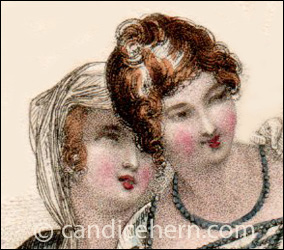
Elements include “braiding the hair in a circle” or ” dividing in front of the forehead with a full plait.” (Photo Evening Dresses January 1811)
(1816) or using “wreaths of lilac” (June 1815) which add a distinctive decorative element. Another unique feature is the “bouquet of full-blown roses” (November 1819) which is a specific and visually striking adornment.
High Tufts and Low Styles
The juxtaposition of very high and very low hairstyles, such as the “high tuft” in January 1817 versus “very low at the sides” in various descriptions, shows an interesting range of styles within the same period.
Variation by Event
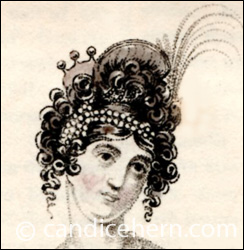
The differentiation of hairstyles for specific events, such as the “court dress” (1820) with ostrich feathers, “ball gown,” and the “private concert costume” (1819) with a bouquet, highlights how hairstyles were tailored for different occasions.
Innovative Use of Materials
The use of accessories including “ostrich feathers” and “pearl bandeau” in court dresses, or “jeweled combs” and “French roses” shows some of the many varied materials and accessories that created distinct looks.
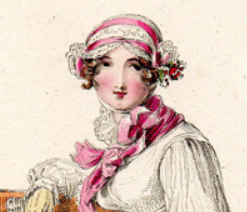
Sources
Candice Hern.com My sincerest gratitude for providing me all the images from her personal collection of fashion plates for this blog post.
English Women’s Clothing in the 19th Century by C Willett Cunnington
Fashions in the Era of Jane Austen by Jody Gayles
